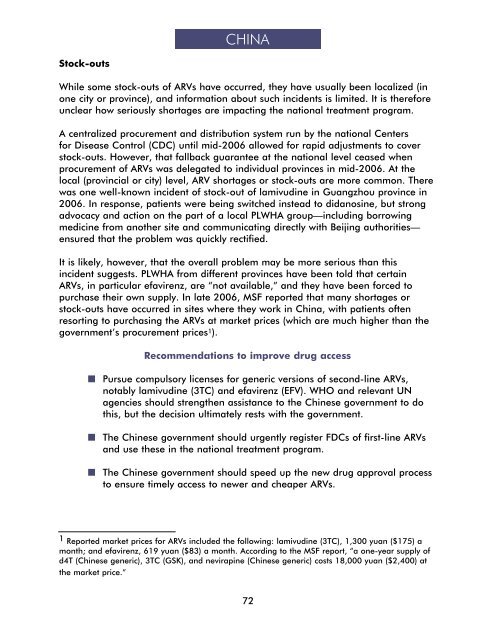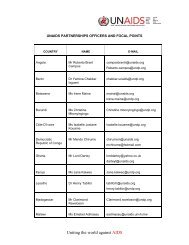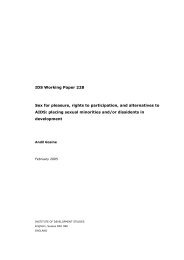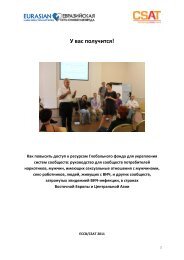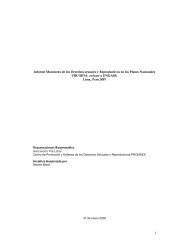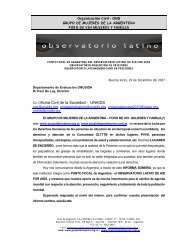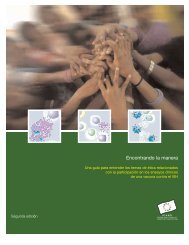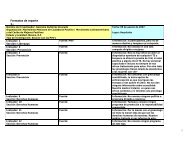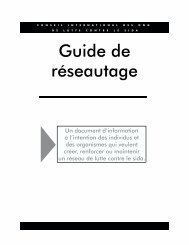Missing the Target #5: Improving AIDS Drug Access ... - CD8 T cells
Missing the Target #5: Improving AIDS Drug Access ... - CD8 T cells
Missing the Target #5: Improving AIDS Drug Access ... - CD8 T cells
You also want an ePaper? Increase the reach of your titles
YUMPU automatically turns print PDFs into web optimized ePapers that Google loves.
CHINAStock-outsWhile some stock-outs of ARVs have occurred, <strong>the</strong>y have usually been localized (inone city or province), and information about such incidents is limited. It is <strong>the</strong>reforeunclear how seriously shortages are impacting <strong>the</strong> national treatment program.A centralized procurement and distribution system run by <strong>the</strong> national Centersfor Disease Control (CDC) until mid-2006 allowed for rapid adjustments to coverstock-outs. However, that fallback guarantee at <strong>the</strong> national level ceased whenprocurement of ARVs was delegated to individual provinces in mid-2006. At <strong>the</strong>local (provincial or city) level, ARV shortages or stock-outs are more common. Therewas one well-known incident of stock-out of lamivudine in Guangzhou province in2006. In response, patients were being switched instead to didanosine, but strongadvocacy and action on <strong>the</strong> part of a local PLWHA group—including borrowingmedicine from ano<strong>the</strong>r site and communicating directly with Beijing authorities—ensured that <strong>the</strong> problem was quickly rectified.It is likely, however, that <strong>the</strong> overall problem may be more serious than thisincident suggests. PLWHA from different provinces have been told that certainARVs, in particular efavirenz, are “not available,” and <strong>the</strong>y have been forced topurchase <strong>the</strong>ir own supply. In late 2006, MSF reported that many shortages orstock-outs have occurred in sites where <strong>the</strong>y work in China, with patients oftenresorting to purchasing <strong>the</strong> ARVs at market prices (which are much higher than <strong>the</strong>government’s procurement prices 1 ).Recommendations to improve drug accessPursue compulsory licenses for generic versions of second-line ARVs,notably lamivudine (3TC) and efavirenz (EFV). WHO and relevant UNagencies should streng<strong>the</strong>n assistance to <strong>the</strong> Chinese government to dothis, but <strong>the</strong> decision ultimately rests with <strong>the</strong> government.The Chinese government should urgently register FDCs of first-line ARVsand use <strong>the</strong>se in <strong>the</strong> national treatment program.The Chinese government should speed up <strong>the</strong> new drug approval processto ensure timely access to newer and cheaper ARVs.1 Reported market prices for ARVs included <strong>the</strong> following: lamivudine (3TC), 1,300 yuan ($175) amonth; and efavirenz, 619 yuan ($83) a month. According to <strong>the</strong> MSF report, “a one-year supply ofd4T (Chinese generic), 3TC (GSK), and nevirapine (Chinese generic) costs 18,000 yuan ($2,400) at<strong>the</strong> market price.”72


